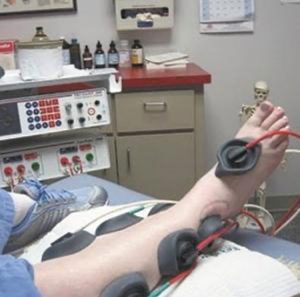



By Dr. Danielle Zappile
 Peripheral neuropathy, a result of damage to the nerves located outside of the brain and spinal cord (peripheral nerves), often causes weakness, numbness and pain, usually in the hands and feet. It can also affect other areas and body functions including digestion, urination and circulation.
Peripheral neuropathy, a result of damage to the nerves located outside of the brain and spinal cord (peripheral nerves), often causes weakness, numbness and pain, usually in the hands and feet. It can also affect other areas and body functions including digestion, urination and circulation.
Diabetic Neuropathy is a group of nerve disorders that are directly caused by diabetes. Although symptoms will vary between patients, the most common symptoms are sharp pain and numbness in feet, legs, hands, and arms, dizziness and weakness from a drop in blood pressure, and the loss of balance and coordination.
Reflex Sympathetic Dystrophy (RSD), also known as Complex Regional Pain Syndrome, is a combination of symptoms affecting limbs, including burning or stabbing pain, tenderness, and swelling; discolored, shiny, or thin-looking skin with increased sensitivity to the area; and abnormal sweating patterns, increased nail and hair growth patterns, stiff joints, and coordination issues.
Chemotherapy-Induced Neuropathy is a peripheral neuropathy caused by the drugs and chemotherapy used to treat cancer damaging peripheral nerves. The symptoms of this condition depend on what peripheral nerves have damage. Typical symptoms include tingling, numbness, vertigo, limited extremity usage, muscle weakness, sensitivity to cold and heat, blood pressure changes, and irregular urination patterns.
Post-surgical neuropathic pain is nerve pain that develops from inflammation of the nerves caused by trauma during surgery. Symptoms may include; tingling or numbness, pins and needles sensations, weakness, and sharp or unsettling pain in the area where surgery occurred. If left untreated, the nerve pain may extend to other parts of the body and cause additional pain.
Brachial Plexus Neuropathy happens when there is an injury near the network of nerves that extend from the spine to the shoulders, arms, and hands.
1. Peripheral neuropathy (2022) Mayo Clinic. Mayo Foundation for Medical Education and Research. Available at: https://www.mayoclinic.org/diseases-conditions/peripheral-neuropathy/symptoms-causes/syc-20352061.
Symptoms can include; pain, lack of movement, and decreased sensation in the shoulders and arms. In most cases, symptoms are only present on the side of the body that sustained the injury.
Post-herpetic neuralgia (PHN) is a condition that arises from complications of the shingles virus damaging the nervous system. The shingles virus itself will show up as blistering or rashes that emit a burning feeling. PHN symptoms can include; sharp, burning, throbbing, or stabbing pain, very itchy skin, sensitivity to temperature, or even numbness.
There are a number of medication-free treatments available.
Hako-Med Horizontal Therapy combines all known forms of electromedical therapy into one breakthrough therapy. Horizontal therapy has been clinically proven to relieve pain and stimulate tissue repair effectively. This therapy boosts communication between cells in bone, muscle, ligament, or nerve tissue through electrical currents and chemical messengers. It is the only patented therapy that simultaneously uses both biochemical and bioelectric effects within the same tissue.
Sanexus RST is an Electric cell-Signaling device. Electric cell- Signaling Treatment (EcST) refers to the use of electronic signal energy waves produced by an ultra-high digital frequency generator (UHdfg). These therapeutic pulsed energy waves are comfortably and non-invasively delivered directly into the body’s desired anatomical region. The Sanexus RST signal energy waves, along with associated harmonic resonance frequencies, are used to physiologically imitate, exhaust or block certain functions of the amacrine, somatic or sympathetic nerve fibers for comprehensive patient treatment success. Even newer research involving electric signal energy waves with expanded and sweeping frequency at a quarter-tone scale rate are referred to as electric signal intonation (ESI).
PDevices that utilize PEMF technology emit electromagnetic waves at different frequencies to stimulate and encourage your body’s natural recovery process. The idea is that pulses at low frequencies can pass through the skin and penetrate deep into the muscles, bones, tendons, and even organs. This process activates the cell’s energy and promotes natural repair mechanisms. Depending on the extent of the tissue, PEMF can address a slight imbalance quickly and can provide more substantial change over time.
Class IV Laser Therapy involves using a handheld wand that emits specific wavelengths of light to accelerate cell generation. The visible red light releases frequencies to the focus area. These frequencies can promote healing by increasing the cell’s energy levels and improving communication between tissue cells. Class IV laser therapy can be used as a stand-alone therapy or in junction with other therapies for optimal results.
This FDA-approved technology relieves pain by expanding the space between the discs. During the procedure, patients don’t experience any discomfort, but will feel their spine gently stretching. This movement causes a vacuum effect within the disc, drawing back displaced disc material to help relieve pressure on nerves and replenish the spine with essential nutrients, fluids, and oxygen to help heal the damaged disc.
Our nutritional therapy incorporates healthy eating guidelines, meal planning, an approved foods list, food journaling, and a nitric oxide boosting kit to support anti inflammation, regulate blood sugar levels, and increase blood circulation. These components work together to improve chronic diseases that cause a patient’s peripheral neuropathy.